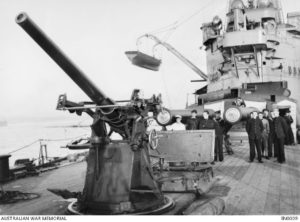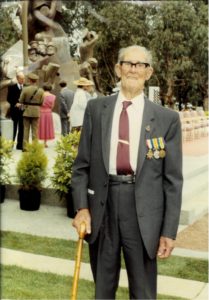Included in a recent contribution to the Society’s archive by the Royal Australian Navy Band in Sydney was correspondence relating to the 99th birthday of a veteran bandsman, Charles Killick who served in HMAS Australia during World War 1. This is a record of an interview taken from the archive. The interview was dated 27 January 1999.
Mr Killick was born in London UK, and learned music from age 10, until age 16 when he performed his first professional job accompanying movie pictures in the small groups needed then. He played cello, and clarinet.
He saw an advertisement in the musician’s union news for bandsmen in the RAN. This was late 1917 at the latter stages of World War One.
On answering this add he was auditioned by Bandmaster Joshua Ventry in London, who said. “you’ll be suitable for our band”, and on 23 JAN 1918, Charles joined the Band of the RAN on board HMAS AUSTRALIA which was in the Firth of Forth.
There, was no initial training. All training was done on board the Flagship, and for one week he was without a uniform, only being issued with underwear etc.
Bandsmen were paid 12 pounds to purchase then maintain their ceremonial uniforms. Charles had to wait for a week until his uniform was ready.
At that stage, a band had been on board the Flagship since 1913, so Charles Considers himself as ‘one of the later members of the band’ (during WW1). He wears two medals for his service during 1918.
The band on board rehearsed in the mess, as hammocks were used and no lockers available on AUSTRALIA (1), so in his words, “it was difficult o keep the (RM style) uniform neat and tidy. The bandsmen were at action stations mainly in the T.S. (transmitting station), with one bandsman in each turret, and 2 in the foretop.
The band did not play at sea, and were fully occupied with their day to day duties. On reaching harbour, the band did the usual jobs on board including colours, where they had to play the National Anthem of every ship in harbour at 0800 hrs.
They also performed ashore at sporting events, marches etc. The ship was ‘teatotal’….no beer or rum like their RN counterparts.

According to Mr Killick, no members of the band were killed in action during WW1, but he remembers a shipmate joining up for WW2, and going down on SYDNEY. His name was Bill Melandri. There may have been other former WW1 Bandsmen who joined during WW2 who were killed also.
The age limit for joining the RAN as a bandsman was 17, but there were ‘boys’ on board during the war. They lived in the ‘boy’s mess’, and there were cadet midshipmen.
One of his memories was being on board HMAS Melbourne when HMAS Australia was scuttled off Sydney on 12th April 1924 and witnessing this sad event. The Flag Band at that time (late 1919-early 1920’s spent time on board Australia, Melbourne, Sydney and Brisbane.
On ‘paying off’ Charles Killick joined the ‘moving picture’ theatre circuit playing first in Kings Cross following a 12 month ‘lay-off’, and also played in most Sydney theatres playing cello/banjo at the Tivoli, and at the Hotel Sydney, and at David Jones cafeteria where live music was a feature of shopping.
To supplement his ‘very good’ income, he accompanied vocalists for recordings and was paid 5 pounds per 3-hour session. He was ‘on clover’. Then came the ‘mortal blow’, the ‘talkies’!
These talking pictures cost hundreds of musicians their jobs. Mr Killick went along to see the first ‘talkie’, “The Jazz Singer” to see what had cost all those jobs, and tried to see the band playing, only to realize that the music was coming through ‘speakers’.
From there on, it was tough times. Very few Australian males had work, and a person would do almost anything. He became very depressed, with his wife and 3 children to support.
Just before he lost his job, he had purchased a small wooden cottage in Manly for 186 pounds. The first work he could find was cleaning theatres, and this kept him going until he gained work with the Civil Construction Corps helping to build Cockatoo Dock and the Garden Island Dry-Dock. This was during WW2.
He then went to Garden Island and asked for a job, gaining employment as firstly an electrician’s off-sider, then a fitters off-sider, until he found work in the pumping-station of the dry-dock. Eventually, one of the permanent employees won the lottery, so Charles fronted the Naval Officer-in-Charge of GI and applied. It was not until he mentioned that he had served in the RAN for 7 years that he secured this job.
Mr Killick’s wife passed away in 1945 from breast cancer, and he stayed in the job at GI until he turned 65 in 1965.
Mr Killick visited his place of birth in 1978, and at that time had two brothers living in the UK. One of these gentlemen phoned Charles on his 99th birthday in January 1999.
His sense of humour was apparent when asked if he was certain of a date, he said…. “Who is going to contradict me?”
Charles passed away on 7th August 2000.

at opening of Navy Memorial Canberra 1986




